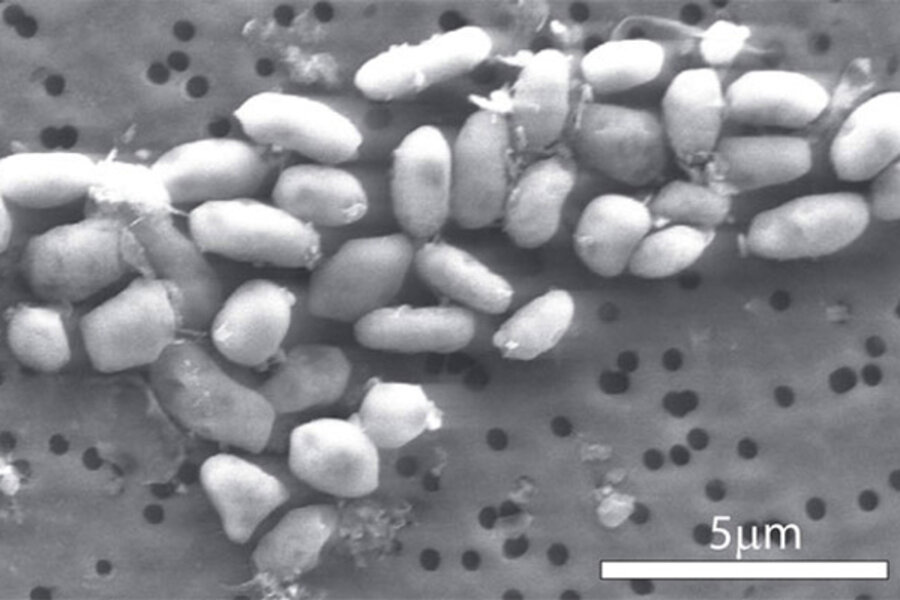How alleged 'arsenic munching' bacteria survives in toxic Calif. lake
Loading...
Bacteria that became famous for their alleged "arsenic-munching" ability, a phenomenon later proved unlikely, may have evolved to sport proteins that filter out the toxic element, new research suggests.
The bacteria, called GFAJ-1, a member of the genus Halomonadaceae, live in California's Mono Lake, amidst concentrations of arsenic that would kill most other life forms. During a 2010 NASA news conference, Felisa Wolfe-Simon, then of NASA's Astrobiology Institute, announced GFAJ-1 was incorporating arsenate (a form of arsenic) into its DNA in place of phosphate (a compound commonly used by life).
Though the announcement was met with plenty of skepticism, one argument behind the swap was the fact that arsenate and phosphate are chemically similar, as both are atoms bonded with four oxygen atoms.
Now, at the Weizmann Institute of Science in Israel, a team led by Dan Tawfik and Mikael Elias found GFAJ-1 is equipped with a "filtering" mechanism that single cells are known to use for keeping out toxic arsenate. [Extreme Life on Earth: 8 Bizarre Creatures]
Blocking out arsenate
They found these proteins in GFAJ-1 are very specific — they don't bind easily to arsenate at all, despite the similarity to phosphate. The reason? An arsenate ion has a slightly different shape than a phosphate ion. At the point where phosphate binds to the protein, the angle between the oxygen atom, a hydrogen atom and the protein is 179.1 degrees. The strength of the bond would be strongest if it were 180 degrees.
Meanwhile, an arsenate ion binds with an angle of 162 degrees, making a much weaker link. It isn't just the single bond, though, that makes the difference; there is more than one such hydrogen bond that links the phosphate to the protein. "Just one bond wouldn't be enough," Elias said.
When GFAJ-1 needs nutrients, it sends the protein out between its inner and outer membrane (called the periplasm). The protein picks up phosphate and delivers it to the inside of the cell. It doesn't link to arsenate as strongly, so it is much less likely to bring it in.
The selectivity is so good that the protein can be exposed to arsenate levels 3,000 times those in Mono Lake without binding to much of it at all, the researchers said. [Stunning Images of Mono Lake]
Refuting arsenic life
The findings, published in the Oct. 4 issue of Science, come after two other papers, published in July, called Wolfe-Simon's work into question.
One paper, from a team led by Marshall Reaves at Princeton and Rosie Redfield at the University of British Columbia, attempted to duplicate Wolfe-Simon's finding that GFAJ-1 had arsenate in its DNA; they found none. The second study, a team led by Tobias Erb of the Swiss Federal Institute of Technology found that GFAJ-1 could grow on very small amounts of phosphorus — smaller than those found by Wolfe-Simon's team.
All known life forms use six basic elements: hydrogen, carbon, nitrogen, oxygen, phosphorus and sulfur. A new life formthat could use arsenic in place of phosphorus would be a major finding.
Reaves said the Weizmann institute paper isn't a complete refutation of Wolfe-Simon's work, as it doesn't directly address the question of whether any life form can incorporate arsenic into its DNA. But it does show how GFAJ-1 might be so arsenate-tolerant, even though it doesn't have a typical set of arsenate-resistance genes. "GFAJ-1, living in abundant arsenate, evolved the commonplace [phosphorus binding proteins] present in other microbes towards ones with dramatically higher specificity," Reaves wrote in an email.
Elias said he hopes future research will reveal how such resistance evolved. Humans and other multi-cellular creatures don't show the genes that produce these proteins, probably because we get phosphates from our food, rather than directly absorbing them from our environment. But among bacteria there are many versions of these genes.
It was, in fact, Wolfe-Simon's work that inspired the experiments in the first place, though Elias had been studying the proteins already. "We saw that and my supervisor [Tawfik] and I said 'that can't be right,'" he said. They were pretty sure that bacteria couldn't use arsenic in their DNA the way Wolfe-Simon seemed to suggest. But coming up with a "filtering" mechanism proved harder to do.
There were three possibilities: either Wolfe-Simon was right, in which case she had found a life form that could operate with a biochemistry unlike anything on Earth; there was some mechanism for expelling arsenate from the cell, or there was some way for the cell to block out the arsenate altogether.
For her part, Wolfe-Simon, via email, said the new research, "represents the kind of careful and interesting studies that aid the community. They have helped us understand molecular level discrimination between arsenate and phosphate in GFAJ-1 and other microbes." She added that her own work spoke to the presence of arsenate in the cells, and that "questions are as to how and where."
Editor's Note: This article has been updated to correct a quote, in which the researcher misspoke about the scarcity of phosphate in Mono Lake.







